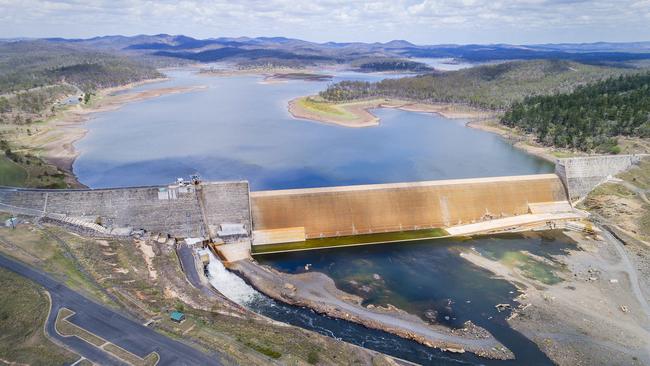Flawed Paradise Dam ‘well below’ safety standards
The wall of Queensland’s defective Paradise Dam has been found to be ‘well below’ safety standards.

The wall of Queensland’s defective Paradise Dam has been found to be “well below” safety standards, with a disaster management review warning it could break up in a flood, causing widespread inundation and putting at least 100 lives in danger.
As weather forecasters predicted 200mm of rain on Tuesday in the area of the state-owned dam, near Bundaberg, the review criticised authorities for not properly informing the public or taking the risks into account in local emergency plans.
Acting Inspector-General of Emergency Management Alistair Dawson was commissioned to conduct a “Paradise Dam preparedness review” after dam operator SunWater was forced to release 105,000ML in September because of safety fears about the 52m-high wall.
The Palaszczuk government has been widely criticised for inaction over structural issues with the $200m dam, built and opened by the Beattie government in 2005, and then refusing to detail the safety fears until this month.
In his 125-page report, Mr Dawson said the dam would unlikely be able to withstand a repeat of the 2013 floods, which caused massive damage to a slab underneath the spillway and led to the evacuation of 5000 people in Bundaberg.
“The current strength of the Paradise Dam spillway is calculated to be well below safety guidelines, and the life safety risk is also calculated to be well above the guidelines’ limit for what society is expected to tolerate if there was a failure,’’ he said.
“SunWater assess that the dam’s stability may be marginal in a one-in-50-year event and that the likelihood of failure is significantly increased in a one-in-200-year event.
“It has a category two failure impact rating, meaning that more than 100 people would be at risk if the dam failed.’’
The 2013 flood, which followed Cyclone Oswald, was deemed a one-in-200-year event. The roller-compacted concrete dam was supposed to have been designed to “safely pass” a one-in-30,000-year flood.
Since September, SunWater has almost halved water levels in the dam to 41.5 per cent, ahead of work to tackle problems, which include the option of tearing the wall down.
Last month, The Australian revealed that authorities had been aware for years that there were design problems with the dam’s “dissipator” — which had led to scouring of the bedrock at the foot of the dam — and that layers of concrete in the spillway wall had not properly bonded.
Mr Dawson’s report said recent technical reports found the most likely “cause of failure” would be either parts of the wall breaking up or its foundations giving way.
“The most likely failure mechanisms are sliding or overturning of sections of the primary spillway or undermining of the sections by the scouring effect of floodwater on the geology just below the dam,’’ he said.
The report found that most local residents were not properly informed of the dangers and that the local council had not received critical hydrology reports. Despite the region’s Emergency Management Plan being revised at least 12 times since 2013, the review found that the heightened risk with the dam was not evident.
Local federal MP Keith Pitt said it was “a scandal” that a dam could pose such a risk.
“When the Palaszczuk government first began releasing water it was spun by them as great news for farmers and a chance to get free water,’’ Mr Pitt said.




To join the conversation, please log in. Don't have an account? Register
Join the conversation, you are commenting as Logout